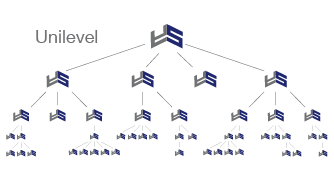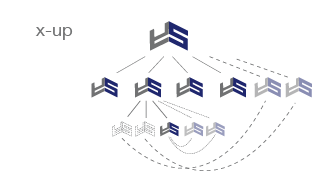A Plethora of Comp Plans. Uniqued.
MLM is a legitimate but misunderstood and highly miscategorized business model. The laws aren’t often fully understood, and those who think they know the law, typically over estimate their understanding. Let us help you understand the context of MLM in eyes of the legal world. We are also here to help you choose proper legal counsel. Not all law firms are made equal, and not all lawyers understand MLM.
Compensation Plans


Compensation plans are made up of more than just STRUCTURE, which governs the structural relationship between a participant, the 'Downline' or Sales Team, and the customer base. Other critical components are: Bonuses, Qualifications, Titles, and Policy. Initially on this site we've outlined only the most typical structures below. In our explanations you should understand that there are mixtures, called Hybrids, which mix and match various structures within a single compensation plan.

The binary plan is so named because of the 2 "Pay Groups", typically called Legs, which make up the core structure of the plan. This structure is typically only for business participants, while a Unilevel is used for tracking customers. This structure is utilized in conjunction with cycled or pooled payouts in commission; 50%/50% balance, 1/3rd - 2/3rd split, and flat % on weakest leg.
Commission is paid based on a pooling of volume on the right or left leg. The advantage of a binary is this pool, which pools the total Group Volume of each leg through infinite levels. It is also for that same reason that early binaries struggled with paying out too much causing many to collapse. Advancement and innovation quickly led to capped payouts individually and company-wide, placing residual volume into a unilevel, releasing (aka Flushing) Group Volume period to period, and other control mechanisms to make a Binary solvent.
The binary became a huge fad in the 1990's and has matured into a common place compensation plan. This plan is currently in high demand in Asian countries. It is typically either LOVED or HATED among industry professionals (there are few who have neutral feelings about the plan). The plan has been used successfully by dozens of highly successful companies, proving its longevity and staying power.

The matrix is named because of its confined structure. Its key features are limited width and limited depth. Commission is paid on a level by level basis; either a percentage of sale price or a set dollar amount is paid as each sale is made. Typically customers are not placed into the matrix (because there are limited spots in a matrix), so customers are placed in "Satellite" positions around each matrix spot, or more commonly referred to as a customer Unilevel.
Proponents of the matrix love the 'team work' they feel it builds as sales teams are forced to work in a structured fashion. As an example, in a 3X matrix there would only be 3 positions available on level 1. The 4th person enrolled would be placed below the 1st person enrolled. This 'spill over' effect is believed by matrix supporters to stir up excitement and help others to start their business'.
Detractors of the matrix plan believe that it causes a "Welfare Mentality" as they fill up with people who take a "wait and see" mentality. Obviously if everyone were to do this there would be little, if any, production of new sales or enrollments. Detractors are also concerned about the 'LIMITED' nature of the comp plan's structure.
As a result of those concerns, advancements in Matrix plans lead to implementing hybid bonuses such as Generational (or Infinity) bonuses, Matching bonuses, and Coded bonuses to pay into deeper levels. The addition of compression and roll-up also aid in "squeezing-out" dead-wood and paying commission further upline. Some companies even introduced "Expanding Matrix" structures that open new front line positions at set qualifications (some might put this type of plan in the Unilevel category). This feature was designed to eliminate concerns about limited income.
Matrix plans also come in a cycling variation typically 2x2, 3x2, or 3x3. As one matrix fills another matrix is started. Commission in these types of matrix compensation plans are typically paid as a "CYCLE" occurs, once a matrix is filled. Typically these structures have a difficult time meeting legal muster, but it can happen with the right design.
The matrix is here to stay as a common structure in MLM. It is also a polarizing comp plan. Like tha binary, people typically love or hate a matrix.

The Unilevel plan is so named because all sales and enrollments are put on ONE level, direct to you. This is the most typical compensation structure, and it is also the least controversial. Both customers and participants are entered into its structure on the front line or first level of their 'sponsor' or 'referrer'. Like the matrix, commission is paid level by level.
It's flexibility to add bonuses (creating a hybrid), it's simplicity to explain, and because it's typically less complicated to program the Unilevel is the most highly used compensation structure in MLM. When you consider affiliate marketing, customer reward programs, insurance, and real-estate business models you'll soon realize that the Unilevel plan will be the dominant compensation plan for a long time to come.
An old dog, learning new tricks: The stair step break-away is one of the oldest implementations of a unilevel plan, or any compensation plan for that matter. It has become less and less common as advancement in technology allow for customized and specialized bonus structures, where a hybrid compensation plan is more the rule these days than the exception.
Detractors of this plan site limited depths (not considering bonuses), and concerns regarding team work as key problem areas for the Unilevel. While proponents of the Unilevel comp plan point to it's structural simplicity, and ease of explanation, along with a comment or two about paying people fairly, as reason for their love of the plan.
The plan itself is synonymous with MLM and although it has been adapted thousands of times over, its core tenants are likely to be around as long as MLM itself.

The Aussie Twist! Legend has it that the first X-up comp plan was designed by an Australian network marketer who was looking for a way to optimize leverage. Often implemented a 2-up, the X-up compensation model is unique. The first X number of people you refer are passed up to your sponsor and treated as "Training Sales", and you're now considered 'qualified'. The leverage comes into play when the first person AFTER you are qualified enrolls and you work with them to make their first X number of sales, which in like fashion will be passed up to your front line. This pattern is repeated the first X number of sales made by each new associate on your front line after you are qualified.
Some have classified an X-up as part of the Unilevel family, and there is validity to that. Some have also argued that it isn't truly MLM because there is only ever 1 level that someone will get paid on. Technically that's not accurate. It is Multi-level because you are paid on sales made by someone else, thus 2 levels.
There are many legal pot holes for this plan. While the structure itself is not illegal, it is often implemented illegally and many companies with this compensation plan have been closed by FTC and AG's. If you are considering this compensation plan particularly, be sure to work closely with a competent MLM attorney, consultant, and software vendor.
Detractors of this plan feel that passing up the first few sales hurts the new business participants, as most participants sponsor only 2-3. On the other hand, proponents point to the powerful leverage and simple qualifications as balancing out any loss.

The Straighline is just that a straight line. Everyone enrolled is placed in a direct line, regardless of who the sponsor is. When X new people are put into the line the top person in line "cycles" and is paid.
This plan by default faces legal lottery and/or ponzi difficulties. Because of this to our knowledge there aren't any straight line plans that have survived very long. Most experts don't currently view this plan as a legitimate compensation model.



















